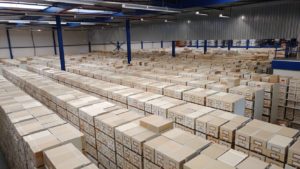
I’m just back from the Netherlands, where bikes rule the road but canals force all the roads to meander and curve so you are never quite sure where you’re headed. I was lucky enough to have the chance to give a talk about jellyfish at the Naturalis Biodiversity Center, one of the oldest natural history museums in Europe and home to a collection an astonishing 42 million strong. Unfortunately for me, but fortunately for all the items stored in the collection and the amazing people who work on them, all the collections are closed until 2018 for a big remodel. But I was able to hunt in the electronic archives and found out that the holotype (the specimen that defines a species) of the nomadic jellyfish (Rhopilema nomadica) that I swam through in Israel is deposited there.
 I also had a chance to tour the Naturalis’ extensive botanical collection–about three-quarters of a million items that reach back to the swasbuckling times of Captain Cook. Looking out over the sea of boxes, each holding several sheets of special paper on which dried plant specimens from around our planet are preserved, I couldn’t help but wonder about all the mysteries of biology that are yet to be solved.
I also had a chance to tour the Naturalis’ extensive botanical collection–about three-quarters of a million items that reach back to the swasbuckling times of Captain Cook. Looking out over the sea of boxes, each holding several sheets of special paper on which dried plant specimens from around our planet are preserved, I couldn’t help but wonder about all the mysteries of biology that are yet to be solved.
Which is a great segue to the reason why I trekked to the land of tulips and coffee–seriously, the Dutch know how to make a great cup of coffee–in the first place. The wonderful people at the Naturalis Newsroom helped me explain the mystery I am trying to solve better than I could alone. If anyone reading this has any information on the life of jellyfish biologist Gustav Stiasny, especially during World War II, please let me know using the contact page.
You’re the coolest!